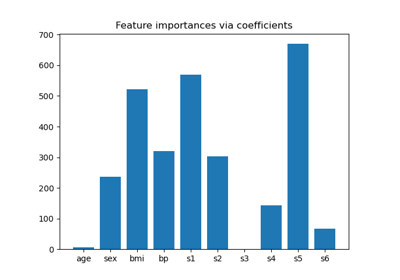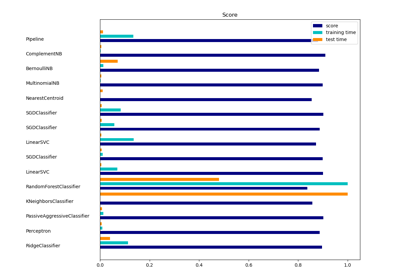sklearn.feature_selection.SelectFromModel¶
-
class
sklearn.feature_selection.SelectFromModel(estimator, *, threshold=None, prefit=False, norm_order=1, max_features=None, importance_getter='auto')[source]¶ Meta-transformer for selecting features based on importance weights.
New in version 0.17.
Read more in the User Guide.
- Parameters
- estimatorobject
The base estimator from which the transformer is built. This can be both a fitted (if
prefitis set to True) or a non-fitted estimator. The estimator should have afeature_importances_orcoef_attribute after fitting. Otherwise, theimportance_getterparameter should be used.- thresholdstring or float, default=None
The threshold value to use for feature selection. Features whose importance is greater or equal are kept while the others are discarded. If “median” (resp. “mean”), then the
thresholdvalue is the median (resp. the mean) of the feature importances. A scaling factor (e.g., “1.25*mean”) may also be used. If None and if the estimator has a parameter penalty set to l1, either explicitly or implicitly (e.g, Lasso), the threshold used is 1e-5. Otherwise, “mean” is used by default.- prefitbool, default=False
Whether a prefit model is expected to be passed into the constructor directly or not. If True,
transformmust be called directly and SelectFromModel cannot be used withcross_val_score,GridSearchCVand similar utilities that clone the estimator. Otherwise train the model usingfitand thentransformto do feature selection.- norm_ordernon-zero int, inf, -inf, default=1
Order of the norm used to filter the vectors of coefficients below
thresholdin the case where thecoef_attribute of the estimator is of dimension 2.- max_featuresint, default=None
The maximum number of features to select. To only select based on
max_features, setthreshold=-np.inf.New in version 0.20.
- importance_getterstr or callable, default=’auto’
If ‘auto’, uses the feature importance either through a
coef_attribute orfeature_importances_attribute of estimator.Also accepts a string that specifies an attribute name/path for extracting feature importance (implemented with
attrgetter). For example, giveregressor_.coef_in case ofTransformedTargetRegressorornamed_steps.clf.feature_importances_in case ofPipelinewith its last step namedclf.If
callable, overrides the default feature importance getter. The callable is passed with the fitted estimator and it should return importance for each feature.New in version 0.24.
- Attributes
- estimator_an estimator
The base estimator from which the transformer is built. This is stored only when a non-fitted estimator is passed to the
SelectFromModel, i.e when prefit is False.- threshold_float
The threshold value used for feature selection.
See also
RFERecursive feature elimination based on importance weights.
RFECVRecursive feature elimination with built-in cross-validated selection of the best number of features.
SequentialFeatureSelectorSequential cross-validation based feature selection. Does not rely on importance weights.
Notes
Allows NaN/Inf in the input if the underlying estimator does as well.
Examples
>>> from sklearn.feature_selection import SelectFromModel >>> from sklearn.linear_model import LogisticRegression >>> X = [[ 0.87, -1.34, 0.31 ], ... [-2.79, -0.02, -0.85 ], ... [-1.34, -0.48, -2.55 ], ... [ 1.92, 1.48, 0.65 ]] >>> y = [0, 1, 0, 1] >>> selector = SelectFromModel(estimator=LogisticRegression()).fit(X, y) >>> selector.estimator_.coef_ array([[-0.3252302 , 0.83462377, 0.49750423]]) >>> selector.threshold_ 0.55245... >>> selector.get_support() array([False, True, False]) >>> selector.transform(X) array([[-1.34], [-0.02], [-0.48], [ 1.48]])
Methods
fit(X[, y])Fit the SelectFromModel meta-transformer.
fit_transform(X[, y])Fit to data, then transform it.
get_params([deep])Get parameters for this estimator.
get_support([indices])Get a mask, or integer index, of the features selected
Reverse the transformation operation
partial_fit(X[, y])Fit the SelectFromModel meta-transformer only once.
set_params(**params)Set the parameters of this estimator.
transform(X)Reduce X to the selected features.
-
fit(X, y=None, **fit_params)[source]¶ Fit the SelectFromModel meta-transformer.
- Parameters
- Xarray-like of shape (n_samples, n_features)
The training input samples.
- yarray-like of shape (n_samples,), default=None
The target values (integers that correspond to classes in classification, real numbers in regression).
- **fit_paramsOther estimator specific parameters
- Returns
- selfobject
-
fit_transform(X, y=None, **fit_params)[source]¶ Fit to data, then transform it.
Fits transformer to
Xandywith optional parametersfit_paramsand returns a transformed version ofX.- Parameters
- Xarray-like of shape (n_samples, n_features)
Input samples.
- yarray-like of shape (n_samples,) or (n_samples, n_outputs), default=None
Target values (None for unsupervised transformations).
- **fit_paramsdict
Additional fit parameters.
- Returns
- X_newndarray array of shape (n_samples, n_features_new)
Transformed array.
-
get_params(deep=True)[source]¶ Get parameters for this estimator.
- Parameters
- deepbool, default=True
If True, will return the parameters for this estimator and contained subobjects that are estimators.
- Returns
- paramsdict
Parameter names mapped to their values.
-
get_support(indices=False)[source]¶ Get a mask, or integer index, of the features selected
- Parameters
- indicesbool, default=False
If True, the return value will be an array of integers, rather than a boolean mask.
- Returns
- supportarray
An index that selects the retained features from a feature vector. If
indicesis False, this is a boolean array of shape [# input features], in which an element is True iff its corresponding feature is selected for retention. Ifindicesis True, this is an integer array of shape [# output features] whose values are indices into the input feature vector.
-
inverse_transform(X)[source]¶ Reverse the transformation operation
- Parameters
- Xarray of shape [n_samples, n_selected_features]
The input samples.
- Returns
- X_rarray of shape [n_samples, n_original_features]
Xwith columns of zeros inserted where features would have been removed bytransform.
-
partial_fit(X, y=None, **fit_params)[source]¶ Fit the SelectFromModel meta-transformer only once.
- Parameters
- Xarray-like of shape (n_samples, n_features)
The training input samples.
- yarray-like of shape (n_samples,), default=None
The target values (integers that correspond to classes in classification, real numbers in regression).
- **fit_paramsOther estimator specific parameters
- Returns
- selfobject
-
set_params(**params)[source]¶ Set the parameters of this estimator.
The method works on simple estimators as well as on nested objects (such as
Pipeline). The latter have parameters of the form<component>__<parameter>so that it’s possible to update each component of a nested object.- Parameters
- **paramsdict
Estimator parameters.
- Returns
- selfestimator instance
Estimator instance.


